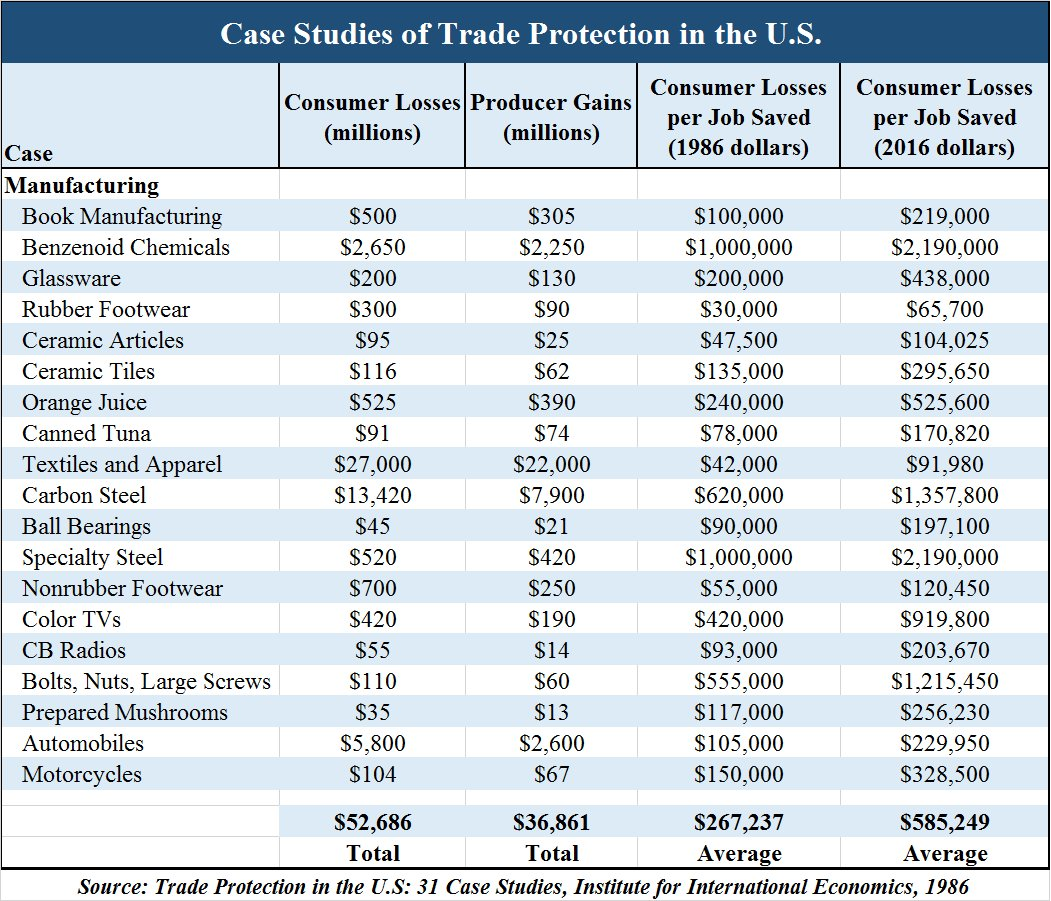Protectionism Was Costly in the Past, And The Future Won't Be Any Different
Spending $500,000 per year to save a $50,000 per year factory job might make sense politically, but only if the true cost of saving those jobs is hidden.
In the name of putting "America First," the Trump administration seems determined to pursue a course of economic protectionism.
As one of his first actions in office, Trump on Monday issued an executive order pulling America out of negotiations for the Trans-Pacific Partnership, a 12-nation free trade deal left unfinished by the Obama administration. Later on Monday, Trump's spokesperson suggested that the new administration might soon withdraw from NAFTA, the 1994 free trade deal signed by the United States, Canada, and Mexico.
Other protectionist policies could be coming. Trump has promised to punish businesses that move jobs out of the United States and has already been making "deals" to keep others from offshoring production.
That might be a winning strategy for Trump politically, but it will leave the country poorer in the long run, says Mark Perry, an economist at the economically conservative American Enterprise Institute. For Perry, that's not an opinion but a reading of empirical economic history.
Perry tweeted this chart on Monday morning (and later expanded the argument in a post at his Carpe Diem blog):

The chart is based on a 1986 study published in the Institute for International Economics examined 31 case studies of protectionist trade policies in the United States. Across 19 different manufacturing sectors, the study found that the costs of protectionism outweighed the benefits, sometimes by a wide margin.
"I think it's a good reality check to demonstrate that even though protectionism might sound good in theory, and might in fact save some U.S. jobs, it will never pass an empirical cost-benefit analysis, which always shows that the costs to consumers are always greater than the benefits to producers, making us worse off on net," Perry said in an email interview.
A lot has changed since the 1980s, of course, but there's little reason to think that the basic rules of trade and economics have gone the way of Members Only jackets and Bananarama.
Not only does protectionism make all of us worse off, but the added costs are huge. When looking at manufacturing jobs, one area where Trump has focused, and updating the 1986 analysis to account for inflation, Perry concludes that it could cost as much as $500,000 per job saved.
"Spending $500,000 to $600,000 per year to save a $50,000 to $60,000 per year factory job might make sense politically, but only if the true cost of saving those jobs is hidden," Perry said.
That last part is important. These costs are never going to be seen on a price tag or a receipt, but are buried within a million transactions that take place all over the country every day. Increasing the cost of manufacturing products or importing them into the country, as Trump has promised to do, will result in those higher costs being passed along the supply chain to consumers.
The supposed benefits of protectionism can be trumpeted—or, perhaps, tweeted—in a far less subtle way.
On Monday, White House press secretary Sean Spicer addressed some criticism of Trump's "deal" with Carrier by doing exactly this.
"He's not focused on statistics so much as he is whether the American people are doing better," Spicer said of Trump's economic views. "Too often in Washington, we get our heads wrapped around a number and a statistic, and we forget the faces and the families and the businesses that are behind those numbers."
Yes, that's a good political talking point—one that I suspect we'll hear a lot more often from the Trump administration in the coming years—but all it does is obfuscate and dismiss very legitimate criticisms, like the one raised by Perry, about the economic consequences of political meddling in the economy.
Read more about Trump's efforts to bribe, bully, beg, borrow, and steal jobs in the newest edition of the print magazine.


Show Comments (93)